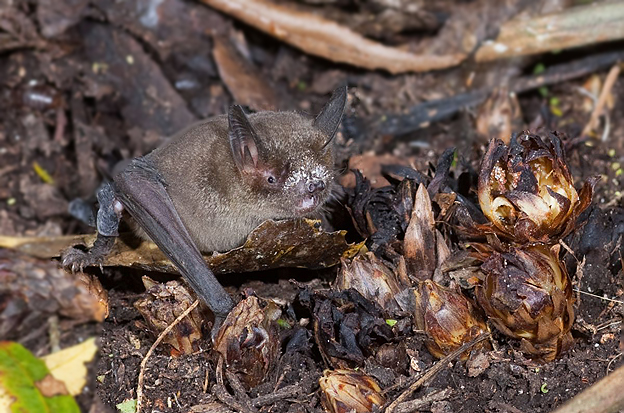Flightless parrots, burrowing bats helped parasitic Hades flower
Ancient dung from a cave in the South Island of New Zealand has revealed a previously unsuspected relationship between two of the country's most unusual threatened species.
[caption id="attachment_4537" align="alignleft" width="210"] A New Zealand short-tailed bat pictured while eating dactylanthus.
A New Zealand short-tailed bat pictured while eating dactylanthus.
Photo by Nga Manu Nature Reserve.[/caption]
Fossilised dung (coprolites) of a now rare parrot, the nocturnal flightless kakapo, contained large amounts of pollen of a rare parasitic plant, dactylanthus (commonly known as "wood rose" or "Hades flower"), which lives underground and has no roots or leaves itself.
Researchers from the Environment Institute's and Landcare Research and the Department of Conservation in New Zealand report the discovery in a new paper published in the journal Conservation Biology.
The paper is titled '' and was written by Jamie Wood (Landcare Research), Janet Wilmshurst (Landacare Research), Trevor Worthy (University of NSW), Avi Holzapfel (Department of Conservation, NZ) and Environment Institute member (Director, ACAD).
[caption id="attachment_4537" align="alignleft" width="210"]
 A New Zealand short-tailed bat pictured while eating dactylanthus.
A New Zealand short-tailed bat pictured while eating dactylanthus.Photo by Nga Manu Nature Reserve.[/caption]
Fossilised dung (coprolites) of a now rare parrot, the nocturnal flightless kakapo, contained large amounts of pollen of a rare parasitic plant, dactylanthus (commonly known as "wood rose" or "Hades flower"), which lives underground and has no roots or leaves itself.
Researchers from the Environment Institute's and Landcare Research and the Department of Conservation in New Zealand report the discovery in a new paper published in the journal Conservation Biology.
The paper is titled '' and was written by Jamie Wood (Landcare Research), Janet Wilmshurst (Landacare Research), Trevor Worthy (University of NSW), Avi Holzapfel (Department of Conservation, NZ) and Environment Institute member (Director, ACAD).

Newsletter & social media
Join us for a sensational mix of news, events and research at the Environment Institute. Find out about听new initiatives and听share with your friends what's happening.
听听听
